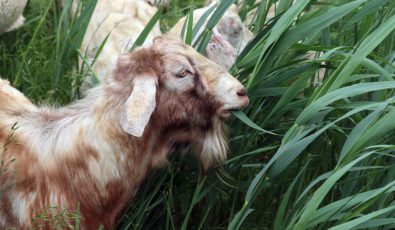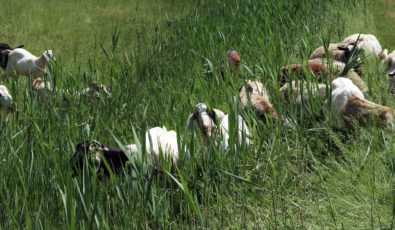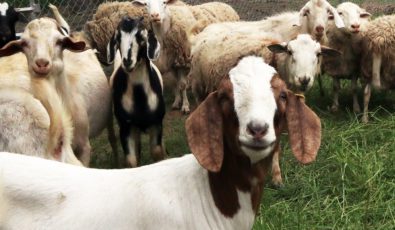Hooved helpers managing invasive species at OPG’s Niagara station
OPG’s Sir Adam Beck Pump Generating Station (PGS) at Niagara Falls is getting some help from an unlikely source to control the growth of an invasive plant species around the site.

Thirty-four hungry goats have been deployed to munch on Phragmites australis – an invasive and fast-growing plant that stands six feet tall. If left unchecked, this pesky plant can prevent OPG employees from accessing areas of the PGS site with important equipment.
The unique pumped storage station can generate 174 megawatts of clean power by pumping its 750-acre reservoir full of water overnight when electricity demand is low, and releasing this water for electricity generation when demand is high.
The goat-grazing pilot project, which OPG’s Environment team launched last October with the help of a local farmer, will wrap up its third treatment later this summer. The creative solution to this fast-growing problem has resulted in the removal of more than 140,000 square feet of the invasive pest in just a few weeks, all thanks to the chewing power of these hard-working animals.

“The Phragmites australis is a particularly pernicious invasive plant that will eventually take over an entire area, making it hard to access,” said Nancy Laser, Environment, Chemistry and Safety Technician with OPG. “This can create operational issues near OPG’s Renewable Generation dams where the growth interferes with efforts to obtain readings of water levels, water quality and rate of flow. We also want to ensure that native species in the area have the ecological environment they need to thrive.”
Traditionally, options for Phragmites removal have included digging them up, tearing them out, applying pesticides or herbicides, or solarizing the soil with tarps. Until now, available solutions have required a lot of human labour that disturbed the soil, making regrowth more prone to weeds.
The key advantage of goats lie in their biology. Specifically, the unique enzymes in their saliva and the bacteria in their gut. Both elements enable them to digest and thrive on all kinds of vegetation, including Phragmites stalks, chutes, flowers and seeds.
“The Phragmites australis is a particularly pernicious invasive plant that will eventually take over an entire area, making it hard to access.”Nancy Laser, Environment, Chemistry and Safety Technician
A goat’s side-to-side chewing motion grinds the seeds, which are no longer viable once they pass through its digestive system. The nutrients from the plants are recycled back into the ground where soil is aerated thanks to the goats’ split hooves. The environment is then enriched for native grassland species to take hold.

Aside from the goats, six sheep have joined the herd to provide a calming presence for the animals. This is especially important given the PGS facility is located beside a busy highway with transport horns, brake noises and high traffic volume.
Elsewhere, OPG has taken action to tackle problematic Phragmites, including at its Western Waste Management Facility in Bruce County. There, staff have deployed Remotely Piloted Aircraft Systems, or drones, to obtain high-resolution photos and videos to map the spread of invasive phragmites in Baie du Doré, a provincially significant coastal wetland.
With the unique program at PGS a success so far, Laser says goats could be deployed at OPG sites around the province to help manage vegetation and protect biodiversity.
Subscribe and stay informed
Sign up to receive the latest news, project updates, and event information from OPG.


